#Kentucky Historical Society
Explore tagged Tumblr posts
Text
Antique Tractor Calendar 2025!
Do you have your 2025 antique tractor calendar planned out yet? Have you started marking dates for upcoming tractor shows, toy shows, tractor drives and plow days? If you are looking for some tried and true shows, check out my 2025 calendar because, it’s time to start making reservations and marking the calendar for antique tractor fun in the New Year! This calendar includes our favorites,…

View On WordPress
#1850&039;s Farm#2024 Albany Pioneer Days#2025 Midwest AG Expo#395h Fall Harvest Days Antique County Engie & Tractor Show#AETA#AJ&039;s Garden Tractor Jamboree#Albany Pioneer Days#Allis Chalmers#American Thresherman Association Show#Antique Engine and Tractor Association#antique tractor#antique tractor calendar 2025#antique tractor shows#Apple Country Engine and Agriculture Center#Atkinson Ilinois#Badger Steam & Gas Show#Badger Steam and Gas Flea Market#Baraboo#Baraboo Wisconsin#Biggest Little Tractor Show#Bird City Kansas#Bluegrass Chapter of the American Truck Historical Society#Bob Carson#Bryan Ebbenga#Butler Haynes Park#Butterfield Minnesota Steam and Gas Engine Show#Campground#Canadian engines#Central Kentucky Antique Machinery Association#Central States Reunion
0 notes
Text



'Graveyard Quilt' handsewn by Elizabeth Roseberry [Mitchell] of Ohio to commemorate her deceased children John Vanetta, and Matthias. From the Kentucky Historical Society collections.
995 notes
·
View notes
Text
Cabin Fever! How the log cabin shaped American history 🪓
Cabins have long been a symbol of the American frontier spirit, a testament to self-reliance and ingenuity. They played a vital role in the early settlement of the United States and have become an enduring symbol of the nation's pioneering past.

Early Colonial Period
Cabins were an essential form of shelter for European settlers in the 17th and 18th centuries. Built from logs with notched corners, cabins were relatively simple to construct, allowing settlers to establish shelter quickly. This design, known as the log cabin, became synonymous with frontier life.
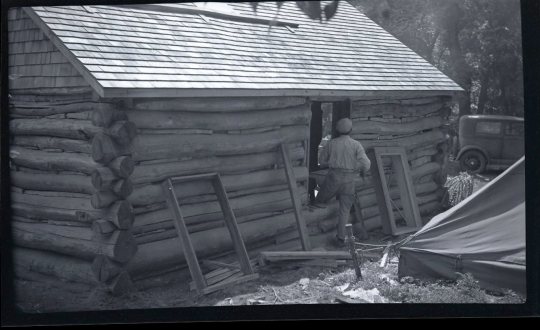

Abraham Lincoln's Birthplace
One of the most famous cabins in American history is the one where Abraham Lincoln was born on February 12, 1809, in Hardin County, Kentucky. The symbolic importance of Lincoln's log cabin birthplace reflects the "log cabin to White House" narrative that emphasizes his rise from humble beginnings. Though the authenticity of the existing cabin at the Abraham Lincoln Birthplace National Historical Park is disputed, it still stands as a symbol of American perseverance and determination.

Western Expansion
As pioneers moved westward, log cabins continued to play a vital role in American expansion. The log cabin's simplicity made it an ideal choice for settlers needing to build shelter quickly. Many of these cabins became the nucleus of burgeoning communities.

Thoreau's Cabin at Walden Pond
In the 19th century, cabins also began to symbolize a return to nature and simple living. Henry David Thoreau's cabin at Walden Pond, where he lived from 1845 to 1847, became an emblem of deliberate, contemplative living. Thoreau's experiment was not only a personal retreat but also a critique of modern society, and his cabin remains an iconic representation of the American transcendentalist movement.

Presidential Retreats
Cabins have also served as retreats for American presidents. Camp David, officially known as the Naval Support Facility Thurmont, is the country's premier presidential retreat, featuring rustic cabins. It has been used by presidents for rest and diplomatic meetings since Franklin D. Roosevelt's administration.
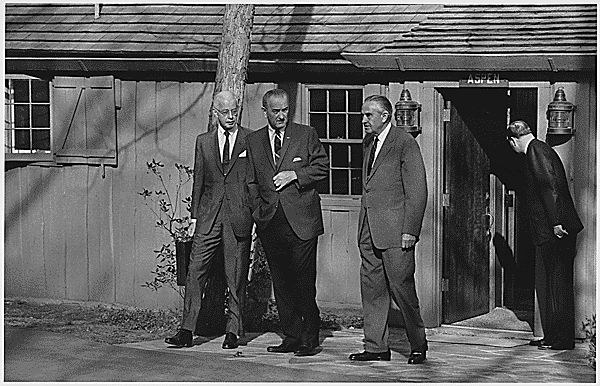
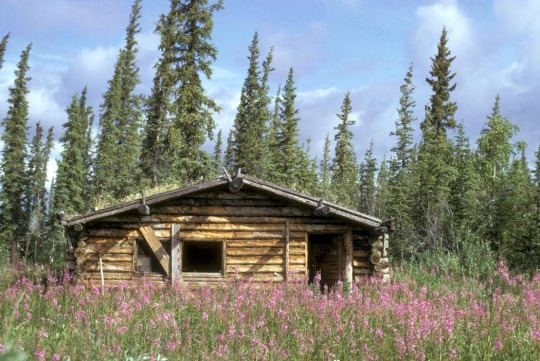
Cabins in Modern Culture
In modern times, cabins continue to symbolize simplicity and a connection to nature. They are often associated with vacation retreats and are emblematic of a desire to return to a less complicated way of life. Check out the hundreds of photographs of cabins in our Catalog!
282 notes
·
View notes
Text
Pink Silk Ball Gown with Large Puff Sleeves, c.1890s


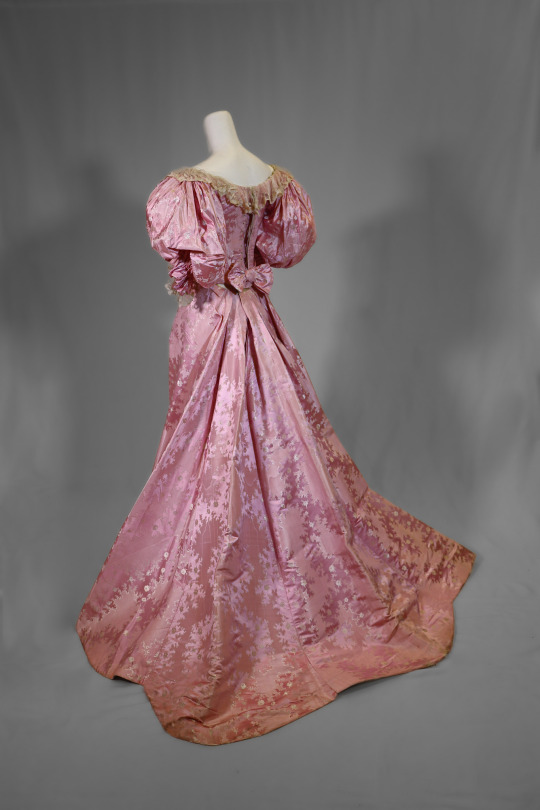

This exquisite pink silk ball gown was donated by Elizabeth Philipse Iselin, wife of Ogden Curtis Noel (1935-2019). The two lived on Silvermine Road in New Canaan with their family. The dress belonged to Elizabeth’s great grandmother, Carolyn Lydia Goodridge (Mrs. John H. Iselin Jr.) who was married in 1899. Carolyn wore the gown at the Bradley Martin Costume Ball at the Waldorf Astoria on February 11, 1897- a social event rating two full pages in the New York Herald. It was labeled by Kentucky newspaper Lexington Leader at the time as “the most splendid fancy dress ball ever given in America”. The interior label of the dress reads “Mme A. Donova, 280 Madison Avenue.”
This dress is a striking example of ball gowns in the 1890s. Women’s daywear was characterized by stiff, high collars and tight sleeves extending to the wrist. Bodices also featured large puffed sleeves at the shoulder, and skirts lacked the large bustle of previous decades. Eveningwear, however, was often much more revealing. Ball gowns such as the pink silk dress had low, wide necklines- a stark contrast to the conservative attire worn just hours before. Sleeves were shortened to show off bare arms, and skirts extended outwards in a trumpet shape, often with a short train.
New Canaan Museum and Historical Society
265 notes
·
View notes
Note
I have an image in my head of Beckett deciding to visit a creation museum just for the hell of it cuz he felt bored, and stands around bemused as he takes in the absurd exhibits and displays purporting to show that humans really did coexist with dinosaurs while the tour guide prattles on, unaware that before them stands a cursed, unholy creature of hell(tm).
As a scholar who doesn't believe in Caine I think he would find kine literalist interpretations of the Bible to be very amusing.
I didn't know creationist museums existed [searches DuckDuckGo] oh snap there's a famous one in Kentucky. Doesn't sound as fun as the Center of PostNatural History in Pennsylvania. No idea the connection between creationist belief and demons. A creationist may believe the world is young, but the appreciation of demonic booty is not.
Regardless, you've touched on a fun irony of Beckett. Our fav Noddist believes the story of Caine and Abel mythologizes the transition from hunter + gather society to settled agrarian society. I can't speak to Protestant sects, but today's Catholics and Catholic scholars also believe that. Adam, Eve, Cain, Abel, and Seth may have been literal, historical people, but it's impossible to know for sure. They for sure are narrative archetypes and play out the consequences of original sin (aka whatever triggered life to suck sometimes). Some scholars think Caine and Abel play out the tensions between nomadic desert tribes and the establishment of cities. Scholars propose that Caine founded the first city, but it was tiny and sucked major ass. Catholic Encyclopedia Answers here.
Another fun element of your proposed scenario is Beckett was definitely alive for Catholic scholars to go bananas about the Ussher chronology of earth. That's the one referenced at the beginning of Good Omens, if you've watched/read/listened to that. Some fucking nerd interpreted the Book of Genesis super literally so he could make Ye Official Timeline. Earth is a Libra. I bet Beckett hated Ussher with a passion 😂 He was probably SO glad when Ussher's ideas lost popularity.
Nowadays Catholicism has no official teaching on the age of earth, but there is an injunction to celebrate and uplift science and scientific thought: the findings of modern science "[...] have splendidly enriched our knowledge of the age and dimensions of the cosmos, the development of life-forms and the appearance of man. These discoveries invite us to even greater admiration for the greatness of the Creator, prompting us to give him thanks for all his works and for the understanding and wisdom he gives to scholars and researchers," (Catechism 283). The Cathechism is like this brick-sized synthesis of Catholic theology and morality. I think the closest Jewish equivalent would be the Mishneh Torah? It's a lot of Catholic Thought™️ brought back down to earth so the layman can look up references and specific questions.
In any case, World of Darkness dropkicks all progression of theological thought out the window and says Caine is literally real, literally a vampire, and literally wants to boink Beckett.
Thanks for the ask! This was fun to think about. I feel like you activated by Catholic trap card, haha.
#ask#chinesegal#text post#vampire the masquerade#vtm#beckett#cuthbert beckett#vtmb#vtm caine#world of darkness#wod#gangrel#clan gangrel#vtm beckett#beckett vtm#beckett vtmb#catholicism#center for postnatural history
12 notes
·
View notes
Text



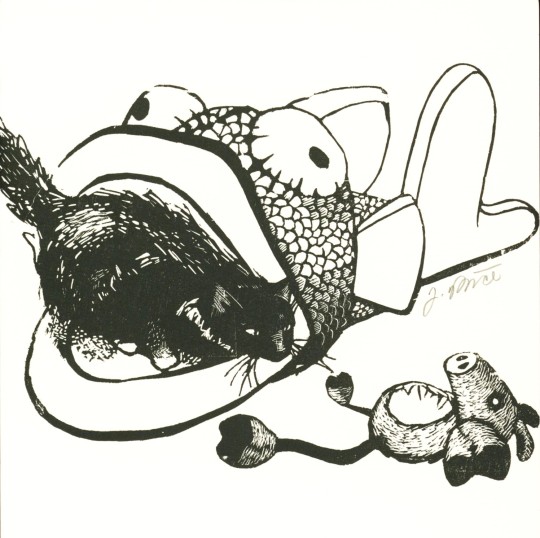
Wood Engraving Wednesday
JOANNE PRICE
On this first Wood Engraving Wednesday in November, we mark the day with this wood engraving by Kentucky artist and engraver Joanne Price from the 2020 calendar of the Wood Engravers’ Network (WEN). Price is the founder of Starpointe Studio, specializing in printmaking and book arts in rural Kentucky. Price has been President of the Wood Engravers’ Network and is an elected member of Britain's Society of Wood Engravers. About her work, Price writes:
My ideas and images are interpreted through the bold but delicate marks of wood engraving. Wood engraving’s intimate scale and slow pace provide a welcome respite from our cyber-fast world. It is charmingly mysterious and feeds my need for quiet concentration and hands-on creative productivity. My ideas emerge from folk/fairy tales, everyday life, and nature, and are often explored through series.
Price maintains a particular interest in the environment and the natural world:
Wood engraving’s historic use in science and literature provides a natural vehicle for these ideas. Utilizing micro and macro perspectives I strive to connect art and science in a way that I hope pushes past mere illustration.
Our copy of the calendar is a donation of WEN member and Wisconsin resident Tony Drehfal.

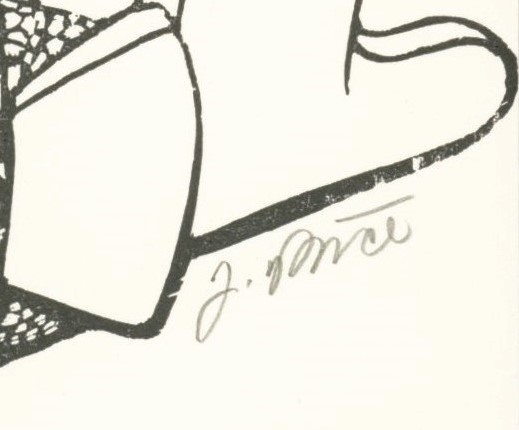
View more posts with work by Joanne Price.
View more posts from the 2020 WEN Calendar.
View more posts with wood engravings!
-- MAX, Head, Special Collections
#Wood Engraving Wednesday#wood engravings#wood engravers#women wood engravers#Joanne Price#Wood Engravers' Network#WEN#WEN Calendar#Starpointe Studio#Tony Drehfal
25 notes
·
View notes
Text
Exactly what uniforms were worn by state militia in the War of 1812 is a debatable question. Surely, many men wore hunting frocks and other irregular types of clothing; the United States struggled to field a professional fighting force.
But there is a certain trend I have noticed in how militia are depicted. You have, say, Kentucky militia—the Hollywood version!

(By artist Andrew Knez Jr., c. 2019, this is supposed to be at the Battle of New Orleans in 1815).
And then you have—with an actual extant uniform—a Kentucky War of 1812 soldier's coatee, reality version!

This belonged to a well-known public figure, Charles Stewart Todd, and you can find it in the Kentucky Historical Society's collection! It is not a manipulated image: he really did that with padding and (I assume) a Regency-style men's corset.
Another example of a real, extant Kentucky militia coatee belonging to Jarvis Jackson shows distinct Napoleonic era military style—and it's not a fringed hunting frock. He probably wore it with Hessian boots, not mocassins.

Anyway. I am slightly in a tizzy about this. Primary sources are few and far between, and I feel like I'm battling some kind of 1950s TV show mythology with coonskin caps.
#war of 1812#kentucky militia#military history#uniforms#dressed to kill#napoleonic#1810s#20th century ideas about rugged masculinity vs. what these frontier fighters actually wore#they liked tophats with cockades and plumes#they wanted to look nice by the standards of their own time!#dress history
19 notes
·
View notes
Text
On this day in 1886: Black abolitionist shares Underground Railroad strategy ⋆ Michigan Advance
On Jan. 17, 1886, Black abolitionist William Lambert revealed that he was part of a secret order called, “African American Mysteries: Order of the Men of Oppression.” He made the declaration in a Detroit Tribune newspaper article.
Lambert and others used codes, passwords and secret handshakes to help slaves gain freedom along the Underground Railroad, the Detroit tailor said.
“These and other abolitionist efforts, by both groups and individuals, assisted thousands of fugitives on their travels on the Underground Railroad in Michigan,” according to the Detroit Historical Society. William Lambert | Burton Historical Collection, Detroit Public Library
The “railroad” was a multi-state network of men and women, Blacks and whites African American who offered shelter and aid to escaped enslaved people from Southern states like Kentucky, Alabama, Georgia and Mississippi.
President Abraham Lincoln issued the Emancipation Proclamation on Jan. 1, 1863, ending slavery in America.
Born in Trenton, N.J, Lambert was 21 when he arrived in Detroit in 1838. As a leader in the Underground Railroad movement, Lambert assisted in the escapes of Thornton and Rutha Blackburn in 1833. They were slaves from Kentucky.
In 1837, Lambert helped to form the Detroit Anti-Slavery Society. It included prominent Black abolitionists Robert Banks, and Madison Lightfoot as well as prominent whites Edwin Cowles, Robert Steward and Shubael Conant.
In 1840, Lambert addressed the Michigan Legislature and challenged the body to amend the state constitution to allow for African Americans to be given full citizenship.
Three years later, Lambert also participated in a two-day Negro Suffrage Convention which was held at Second Baptist Church, Michigan’s first Black church congregation located in Detroit. There, 23 delegates discussed and planned a strategy to win voting rights and sustainable employment for African Americans.
A resolution adopted by the assembly read as follows:
“Whereas we find ourselves existing in this state, with no marks of criminality attached to our names as a class — no spots of disloyalty dishonoring our birthright; and whereas, we yet find ourselves the subjects and not the objects of legislation, because we are prevented from giving an assenting or opposing voice in the periodic appointments of those who rule us.”
Lambert died in 1890 at age 71.
#Detroit#African Mysteries#African American Mysteries#Black Revolutionaries#On this day in 1886: Black abolitionist shares Underground Railroad strategy#William Lambert
11 notes
·
View notes
Text
Fascinating article in the NYT about the last two Shakers (gift link from Eric Conrad on bluesky). I've long wanted to write an FF historical romance about two women in the group. Beyond that, I think they're an important case in showing how *when* historical people were radically egalitarian it was in their own terms, not because they were somehow "modern" or "like us" -- they found their way to it using their own cultural tools.
Too many "historical" stories depict a historical person with egalitarian ethics as basically a person who thinks in "modern" terms - as if "modern" is the pinnacle of human beings (and which "modern" do we mean exactly?) given all the wrongs we're embedded in. It really sacrifices something important, which is realizing how truly different people can think even while trying for good ends.
Some neat quotes:
The youngest Shaker in the world is 67 years old, and his name is Arnold. He lives alongside Sister June, 86, in a magnificent brick building designed to sleep about 70 — the dwelling house of the last active Shaker village in the world, at Sabbathday Lake in Maine. Together they constitute one of the longest-running utopian experiments in America. It’s a triumph, as utopian experiments aren’t known for their durability, though the impulse — to start afresh apart from the mess of mainstream society, to reinvent society with like-minded people — has always been strong here. Out of the many that America has fostered, this is one of the most abiding. Out of the tens of thousands of Shakers who have lived out their faith in the last quarter-millennium, these two remain.
...The Shakers have been breaking bread in this manner since before the Revolutionary War. In 1774 a blacksmith’s daughter named Ann Lee led a small group of refugees from Manchester, England, where they had been jailed and beaten for following her heretical teachings: that God was both male and female, a Father-God and Mother-God. She taught that true virtue required sacrificing individual desires for the collective good, including total celibacy. She preached pacifism and the equality of the sexes and races. (Black Americans were welcomed as early as 1790, and communities purchased freedom for their enslaved members.) Her followers lived together in largely self-sufficient communal villages, everyone a brother and sister to one another. To join, prospective Shakers had to divest themselves of their worldly attachments — property, marriages, debts — and dissolve their families: Husbands would live with the brothers, wives with the sisters, and children would be raised separately by the brethren assigned to child care. Shakers believe their calling is to manifest the kingdom of God on Earth, and their Millennial Laws, first drawn up in the 1820s, specified that every detail of their built environment should express that vocation. They organized their lives around the belief that work is a vehicle for the divine: When early Shakers planed wood for a barn, or designed that barn, or sheared sheep, or rolled out a pie crust, they understood themselves to be worshiping. Every day, through their labor, the flawed world in which they lived could be made more whole.
Though it’s hard to get a precise count, at Shakerism’s height in the 19th century, the community numbered roughly 5,000. Over its history, 19 Shaker communities spread out from New England as far west as Ohio and south into Kentucky and Florida. Now some of the most tangible products of their philosophy — the furniture — are more well known than the religion itself. Their chairs are in the Metropolitan Museum of Art; knockoff replicas are sold in big-box stores. The traditional Shaker “aesthetic” is so popular that The New York Times’s Style section ran a 2022 feature on the influence of Shaker design on contemporary “tastemakers.” When I mentioned to a friend that I was writing about the Shakers, she replied, “Are those the furniture Christians?”
...Once, after supper, I asked Brother Arnold, “What makes a good Shaker?” He was in the recliner in the corner of the kitchen, looking at his phone. He told me about the willingness to labor, both physically and spiritually, in perpetuity. This is what it takes. Not everyone can do this work knowing that they might never see the fruits of their labor. “The idea that we need to see results in our lifetimes — that’s not how the Shakers actually teach us to think about those types of achievements,” Graham pointed out to me. “That’s man’s time, not God’s time.” Brother Arnold said to me more than once that Shakers live “in the eye of eternity.”
There are a lot of people around Sabbathday Lake striving to labor in the eye of eternity these days. Maybe a new Shaker will come this year; maybe not. But in the Meeting House this summer, people are singing. Lavender is drying from the eaves of the old sisters’ shop; future harvests will hang in the new herb house. A concept of survival and flourishing that isn’t primarily concerned with linear time or material gains may be the most radical thing about this historically radical American religion, and the one most resonant with a world that is experiencing, constantly, its own existential threats and calamities. It is obvious by now that everyone and everything is dying and living all at the same time, that failure and hope are all mixed up, and still the sheep are lambing and the roof has sprung a leak again and you’ve been snappish and petty even though you swore you’d be better and someone has to make breakfast and even breakfast can be a gesture of belief in the world as it could and should be.
3 notes
·
View notes
Text

a piece i did for a class on native american history, inspired by Murder on the Red River by Marcie Rendon (more info under cut)
“She bounded down two concrete stairs and stepped out on to the green grass of the campus mall, surrounded on either side by thick stately oaks. She could tell each one had been strategically planted along the winding sidewalks between the red brick buildings. Even with groups of students sitting on the grass, leaning against their trunks, the trees seemed lonely. Nothing like the oaks along the river that grew where they wanted to grow and leaned in and touched each other with their middle branches, whose voices sang through their leaves like the hum of electric wires running alongside the country roads.” From Murder on the Red River
This piece is inspired by Murder on the Red River, a mystery novel by Marcie Rendon. It’s about Cash Blackbear, a young Ojibwe woman who investigates the murder of a Native man. Cash was taken from her mother and siblings as a young child and lived in a series of foster homes, most of which were abusive. About a third of Native American children were taken from their parents and placed in foster homes, even when they could have been placed with relatives instead of being separated from their community members and culture. Native American boarding schools, which also separated children from their families and culture, had mostly all been shut down by the 1970s (Katherine Beane), when Murder on the Red River takes place. But the removal of children to foster homes was just another way that the government tried to force Native Americans to assimilate into white culture. The Indian Child Welfare Act was passed in 1978. It set requirements to keep Native children with relatives when safe and possible, and to work with the tribe and family of children. This act has made progress, though Native children are still adopted or placed in foster care at a higher rate than non-Native children (NICWA). In my illustration, there are four trees, representing Cash, her mother, and her two siblings. In the image on the right, the trees are growing as they do in their natural forest habitat, winding together. In the image on the left, the trees have been planted on the neat lawn of the college campus, a place where white culture is dominant. The trees are apart from each other, separated as Cash’s family were torn apart. They were forced to assimilate as many Native Americans were. The trees are bur oaks, aka Quercus macrocarpa, a species native to North Dakota where the book takes place. Their range encompasses much of the U.S. and parts of Canada (Lady Bird Johnson Wildflower Center). The grass on the right image is Kentucky Bluegrass, aka Poa pratensis. It is invasive to North America. It was introduced in the 17th century from Europe, and is now found all over North America. It is commonly used for lawns and pasture, and can outcompete native prairie plants (North Dakota State Library). The Red River borders North Dakota and Minnesota. The Ojibwe have lived in Minnesota since before the 17th century, after migrating from Northeastern North America over hundreds of years (Minnesota Historical Society). The shape of the Red River traces through the image, weaving and intermingling through the branches of the trees, showing Cash’s deep connection with the land she is from.
Works Cited “About IWCA” National Indian Child Welfare Association, https://www.nicwa.org/about-icwa/ Beane, Katherine, American Indians in Minnesota, 12 March 2024, Nicholson Hall, Minneapolis, MN. Lecture. “Kentucky Bluegrass”, North Dakota State Library. https://www.library.nd.gov/statedocs/AgDept/Kentuckybluegrass20070703.pdf Rendon, Marcie. Murder on the Red River. Soho Crime, 2017. “The Ojibwe People”, Minnesota Historical Society, https://www.mnhs.org/fortsnelling/learn/native-americans/ojibwe-people “Quercus macrocarpa”, Lady Bird Johnson Wildflower Center, https://www.wildflower.org/plants/result.php?id_plant=QUMA2
3 notes
·
View notes
Text
Haunted States of America: Ohio
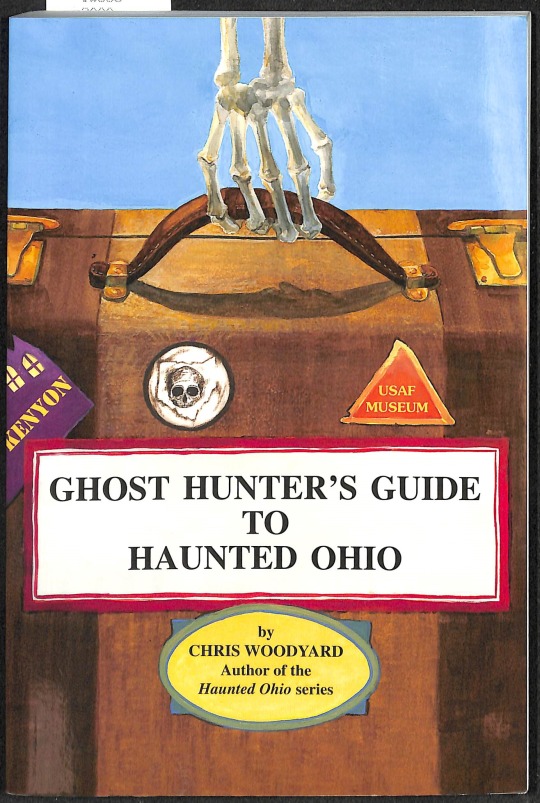
Ghost Hunter's Guide to Haunted Ohio (2000) by Chris Woodyard
You may recognize this author's name from our introductory post to this series: Chris Woodyard, from whose Invisible Ink Collection most of these books come. Woodyard is the author of the popular Haunted Ohio series, as well as a variety of history books about death and death culture in the Victorian era. She describes herself as a Fortean, named after Charles Fort, an American researcher known for his interest in anomalies and skepticism in the scientific method as the source of all knowledge of the universe. For more about Woodyard, visit her website at http://hauntedohiobooks.com/.
Ghost Hunter's Guide to Haunted Ohio focuses on haunted places in the state that are accessible to the public, such as Mansfield's Ohio State Reformatory, the Golden Lamb Restaurant & Hotel in Lebanon, OH, and the Taft Museum of Art in Cincinnati.
Our collection has the first four Haunted Ohio books (I, II, III, IV) by Woodyard, as well as her Spooky Ohio: 13 Traditional Tales (1995). For books about ghosts in Ohio by other writers, check out:
Ohio Ghost Stories (1993) by Shelley Pearsall
Tristate Terrors: Famous, Historic, Female Ghosts of Ohio, Indiana, and Kentucky (1996) compiled by Anne Oscard
Ghost Stories of Ohio (2001) by Edrick Thay
If you would like to know more about Charles Fort and Forteans, we have the books:
The Complete Books of Charles Fort (1974) introduction by Damon Knight
The Fortean Times Book of Close Shaves and Amazing Luck (1999) compiled by Steve Moore
Charles Fort: The Man Who Invented the Supernatural (2008) by Jim Steinmeyer
as well as multiple magazines and fanzines:
Doubt: The Fortean Society Magazine (1970s-)
Fortean Times (1976-)
INFO (1970s-) by the International Fortean Organization
The Browne Popular Culture Library (BPCL), founded in 1969, is the most comprehensive archive of its kind in the United States. Our focus and mission is to acquire and preserve research materials on American Popular Culture (post 1876) for curricular and research use. Visit our website at https://www.bgsu.edu/library/pcl.html.
#bgsu#libraries on tumblr#haunted states of america#books#ghosts#ohio#haunted ohio#chris woodyard#charles fort#fortean#zines
7 notes
·
View notes
Text
State march masterpost (updated as information comes in!)
All times are local time unless otherwise specified. Reblogs are off because this is a living, regularly updated post; please see our website or send an ask for more information! Post you can reblog is here. Alabama: Florence—114 W Mobile St -> 200 S Court St, 3/31, 3:30pm (link) Montgomery—Alabama State House, 3/31, 1pm (link)
Alaska: Anchorage—Dimond Center -> Costco Wholesale, 3/31, 12pm
Arizona: Prescott—Prescott Courthouse, 3/31, 2pm Sierra Vista—Fry and Coronado -> City Hall, 3/31, 3pm (link) Tuscon—Tuscon City Hall, 3/31, 4pm (link)
Arkansas: Eureka Springs—Basin Spring Park, 3/31, 6pm (link) Little Rock—Lucie’s Place, 3/31, 6pm Marion—Brunetti Park -> Marion City Hall, 3/31, 5pm
California: Castro Valley—Castro Valley High School (non-students please join in once the protest has left school grounds) -> Corner of Redwood Rd and Castro Valley Blvd, 3/30, 3:35pm (link) Fresno—N Blackstone Ave & E Nees Ave, 3/31, 4pm (link) Hollywood—Corner of Sunset & Vine, 3/30, 4:15pm Merced—3055 Loughborough Dr -> Laura's Fountain -Applegate Park 1045 W 25th St, 3/31, 4:30pm (link) Pomona—Pomona Pride Center 836 S -> City Hall, 3/31, 4pm (link) Riverside—Back To The Grind Coffee Shop –> Riverside City Hall, 3/31, 4pm (link) Sacramento—Capitol Complex, 3/31, 12pm (link) San Diego—Balboa Park at the Bea Evenson Foundation -> El Prado, 3/31, 5pm San Francisco—Corner of Turk & Taylor -> City Hall, 3/25, 11am (link) | Patricia's Green -> City Hall, 3/31, 2:15pm (link) San Jose—San Jose City Hall, 3/31, 5:30pm (link) Santa Ana—Brad Brafford LGBT Center on 4th, 3/31, 6pm (link)
Colorado: Denver—Civic Center Park, 3/17, 8:30pm | West Steps of the Capitol, 3/24, 11am (link)
Connecticut: Bristol—131 N Main Street, 3/31, 1pm Fairfield—Upper Quad of Sacred Heart University, 3/31, 4pm New Haven—corner of Chaple and Church St, 3/31, 4pm
Delaware: Wilmington—Delaware Historical Society –> Rodney Square, 3/31, 6pm (link)
District of Colombia: Union Station -> US Capitol, 3/31, 3pm (link)
Florida: Altamonte Springs—3/31, 9am (link) Naples—Cambier Park, 3/31, 6pm (link) Ocala—Pine Plaza -> City Hall, 3/31, 3:30pm Orlando—Dr Philips Performing Arts Center, 3/31, 11am Port Orange—Corner of Yorktowne Blvd. and Dunlawton Ave -> Port Orange Regional Library, 3/31, 4:30pm Tallahassee—state Capitol building, 3/31, 2pm (link) Venice—Town Center -> Venice Beach, 3/31, 10:30am
Georgia: Atlanta—state Capitol building, 3/31, 12pm (link) Dalton—3/31, 11am (link) Gainesville—Gainesville Square –> Jesse Jewell Parkway (in front of CVS), 3/31, 5pm Savannah—Forsyth Park -> City Hall & back, 3/31, 6pm
Hawaii: Honolulu—state Capitol building, 3/31, 3:30pm
Idaho: Boise—TBD Shelley—Shelley City Park, 3/31, 2pm
Illinois: Champaign—McKinley Foundation Church Chapel, University of Illinois, 3/31, 5:30pm Chicago—Grant Park, 3/31, 5pm Rockford—1005 5th Ave, 3/31, 5pm (link) Streamwood—7 Augusta Dr –> 7 S Sutton Rd, 3/31, 8am (link)
Indiana: Fort Wayne—Boone Street Playlot -> Allen County Courthouse, 3/23, 3pm (link) | Allen County Courthouse, 3/31, 5pm (link) Hanover—Hanover College Quad, 3/31, 1pm Indianapolis—433 N Capital Ave -> 1 Monument Circle, 3/31, 3pm Terre Haute—Terre Haute Courthouse, 3/31, 5pm
Iowa: Des Moines—state Capitol building (West Capitol Terrace Stage), 3/31, 6pm (link) Dubuque—Dubuque Courthouse -> Washington Park, 3/31, 4pm (link) Iowa City—Pentacrest -> Wesley Center, 3/31, 6pm (link)
Kansas: Lenexa—Lenexa Rec Center -> City Hall, 3/31, 5pm Topeka—state Capitol building entrance, 3/31, 5pm (link) Wichita—121 E Douglas Ave, 3/31, 4pm (link)
Kentucky: Frankfort—front of Annex Building, 3/29, 9:30am (link) | Kentucky State Capitol, 4/8, 1pm (link) Lawrenceburg—Anderson County Courthouse -> 44 Anna Mac Clarke Ave, 4/3, 3pm (link) Lexington—Robert F. Stephens Courthouse Plaza, 3/31, 4:30pm | Outside of the Old Fayette County Courthouse, 3/31, 6pm
Louisiana: Lake Charles—Prein Lake Park, 3/31, 12pm New Orleans—Washington Square Park 700 Elysian Fields Ave, 3/31, 5pm (link)
Maine: Bangor—West Market Square, 3/31, 6pm Portland—456 Congress St, 3/31, 6pm (link) Rockland—Intersection of Main Street and Park Street (near Walgreens and Maine Sport) –> Chapman Park, 3/31, 5:30pm
Maryland: Baltimore—400 E Biddle St, 3/31, 5pm Oakland—32 Oak St –> 305 E Oak St, 3/31, 3pm (link)
Massachusetts: Boston—state house, 3/18, 11am (link) | state house, 3/28, 10am (link) Sunderland—North Star, 45 Amherst Road, 3/31, 12pm
Michigan: Detroit—Woodward-Warren Park, 3/31, 5pm (link) Fenton—Rackham Park, 3/31, 6pm (link) Grand Rapids—Downtown, 3/31, 5pm Lansing—state Capitol building, 3/31, 11am
Minnesota: Saint Paul—state Capitol building, 3/31, 9am (link)
Mississippi:
Missouri: Columbia—701 East Broadway Blvd, 3/31, 5:30pm (link) | Uptown Columbia –> Downtown Columbia, 4/15, 9am Jefferson City—Missouri State Capitol, 3/29, 2pm (link) St Louis—11911 Dorsett Rd –> 715 NW Plz Dr, 4/27, 1pm
Montana: Missoula—Missoula Courthouse, 3/31, 5pm (link)
Nebraska: Lincoln—state Capitol building, 3/31, 5:30pm
Nevada: Las Vegas—Las Vegas TransPride Center -> The LGBTQ Center of Southern Nevada, 3/31, 11am (link)
New Hampshire: Keene—Keene State College Campus Main Entrance -> Center Square, 3/31, 5pm (link)
New Jersey: Flemington—Flemington Historic Courthouse -> Flemington DIY, 3/31, 3:45pm (link) Trenton—State House, 3/31, 3pm (link)
New Mexico: Albuquerque—Civic Plaza, 3/31, 5pm Santa Fe—State Capitol -> the Attorney General's office, 3/31, 11am
New York: Albany—Washington Square Park -> Capitol Park, 3/31, 1pm Canandaigua—7 Mill St, 3/31, 3pm Forest Hills—Forest Hills Station, 3/31, 2:30pm New Paltz—SUNY New Paltz Campus, 3/31, 3:30pm New York City—Union Square -> Washington Square Park, 3/31, 5pm (link) | Times Square, 3/31, 5pm Penn Yan—Yates County Courthouse, 3/31, 3pm (link) Plattsburgh—Hawkins Pond -> Samuel Champlain Monument Park, 3/23, 3pm Utica—Genesee-Parkway Intersection, 3/31, 5pm Westchester—SUNY Purchase College, 3/31, 5pm
North Carolina: Asheville—TBD Mooresville—Freedom Park -> Town Hall, 3/31, 2:30pm (link) Raleigh—John Chavis Memorial Park, 3/31, 1pm Wilmington—Historic Thalian Hall Steps, 3/31, 5pm (link)
North Dakota:
Ohio: Cleveland—Free Stamp @ Willard Park -> City Hall, 3/31, 4pm Cleveland Heights—City Hall, 3/31, 11am (link) Columbus—Goodale Park, 3/31, 5pm Dayton—Lily’s Dayton (329 E 5th St) –> Courthouse Square (23 N Main St), 3/31, 4pm Lakewood Park—Lakewood Park, 3/31, 4pm (link) Madison—Madison Village Square Park, 3/31, 4pm (link)
Oklahoma: Oklahoma City—Supreme Court of Oklahoma -> state Capitol building, 3/31, 5pm Tulsa—Central Library, 3/31, 4pm (link)
Oregon: Bend—Drake Park, 3/31, 5pm Hillsboro—Civic Center -> 145 NE 2nd Ave, 3/31, 5pm Medford—Vogel Plaza 200 E. Main Street, 3/31, 4pm Portland—Tom McCall Waterfront Park -> Pioneer Courthouse, 3/31, 2pm
Pennsylvania: Harrisburg—state Capitol building, 3/31, 1pm (link) Oil City—Oil City -> Franklin, 3/31, 8am Philadelphia—Temple University Bell Tower, 3/29, 1pm (link) | City Hall, 3/31, 6pm (link) Pittsburgh—City County Building, 3/31, 5pm (link)
Rhode Island: Providence—the Wheeler School -> state Capitol building, 3/31, 11:30am
South Carolina: Columbia—State House Grounds, 3/31, 2pm Greenville—300 S Main St, 3/31, 3pm (link)
South Dakota: Brookings—City Council Building, 3/31, 5pm (link) Rapid City—Main Street Square, 3/31, 5pm
Tennessee: Knoxville—Downtown Hilton, 3/31, 10:30am (link) | Gay Street & Market Square (where the water fountain markers are), 3/31, 2pm Memphis—Civic Center Plaza, 3/16, 4pm
Texas: Amarillo—Amarillo Chamber of Commerce -> Potter County Courthouse, 3/31, 5pm Austin—state Capitol building, 3/20, 9am (link) Dallas—Main St Garden Park 1902 Main St, 3/18, 12pm (link) | Pacific Plaza, 3/31, 3pm Houston—Discovery Green Park -> City Hall, 3/31, 11:30am Killeen—101 N College St -> 1114 N Fort Hood St, 3/31, 5:30pm Lubbock—Mahon Library parking lot -> county Courthouse, 3/31, 5pm San Antonio—San Antonio Courthouse, 3/31, 6:30pm (link)
Utah: Salt Lake City—state Capitol building, 3/31, 5pm (link)
Vermont: Montpelier—Montpelier State House, 3/31, 12pm (link)
Virginia: Richmond—Open High School -> state Capitol building, 3/31, 3pm
Washington: La Center—by the bridge into town, 3/31, 5pm Olympia—Heritage Park -> state Capitol building, 3/31, 3:30pm Seattle—SeaTac Airport Station, 3/31, 1pm | Volunteer Park -> Seattle Courthouse, 3/31, 4pm (link) Spokane—Cracker Building, 3/18, 12pm (link) Walla Walla—Pioneer Park -> Land Title Plaza, 3/31, 3:45pm (link) Wenatchee—Memorial Park, 3/31, 4pm
West Virginia: Charleston—3/31, 4:30pm
Wisconsin: Appleton—Houdini Plaza, 3/31, 10am (link) Janesville—Corner of East Court Street/Jackman Street -> Corner of West Court Street/South Locust Street, 3/31, 2pm Kenosha—Civic Center Park, 3/31, 12pm Madison—Library Mall, 3/18, 2:30pm (link) | 534 State St –> Wisconsin State Capitol, 3/31, 12pm Milwaukee—TBD
Wyoming:
CANADA: Toronto, Ontario 3/17, 3pm, US Consulate (link)
#queer youth assemble#march for queer and trans youth autonomy#queer youth#queer pride#queer#trans healthcare#trans rights#trans#trans day of visibility#transgender#activists#activism#youth rights#protest
28 notes
·
View notes
Text
Lincoln Home, social services for Black Americans in early 20th century Pueblo, Colorado
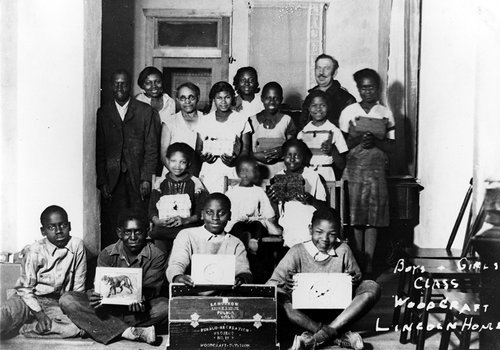
In 1905 The Colored Orphanage and Old Folks Home was known as, "the only home for colored children in an area of seven states." The Lincoln Home was started by the Federation of Colored Women’s Clubs in the city of Pueblo and became the only known Black orphanage in Colorado. Built in 1906, the home moved in 1914 to two small red-brick houses that were built closely together on 2714 North Grand Avenue, where it remained until the city’s segregated orphanage system ended in 1963. In 1997 the Lincoln Home building on North Grand Avenue was listed on the State Register of Historic Properties, and in the early 2000s the building housed the Martin Luther King Jr. Cultural Center. Currently the building serves as a museum which is open to the public and can be toured. Which was a huge honor for Pueblo, Colorado.

Pueblo’s Black community traces its roots to the diverse residents of El Pueblo, the early trading post that was built near the present city in the 1840s. According to the Colorado Encyclopedia, after the Colorado Gold Rush and the Civil War, new Black residents arrived from border states such as Kentucky and Missouri. Between 1870 and 1880 Pueblo County’s Black population grew from 27 to 141. The area’s Black population continued to grow over the next two decades. By the early 1900s, Pueblo’s Black community was developing its own institutions, including the city’s first black newspaper.




Ray Brown and Emily Wilson, Pueblo Heritage Museum Museum Curator and Executive Director, hope to find a home for artifacts from from the Lincoln Home that were collected by Pueblo civil rights icon and Brown’s mentor Ruth Steele. Read the detailed article on their efforts in The Gazette here.

Source: Pueblo Orphanages: Transformation, Pueblo County Historical Society Facebook, The Gazette
Visit www.attawellsummer.com/forthosebefore to learn more about Black history and read new blog posts first.
Need a freelance graphic designer or illustrator? Send me an email.
#Lincoln Home#Pueblo Colorado#Colorado#Colorado history#American history#Black history#orphange#social services#20th century Colorado history#segregation
2 notes
·
View notes
Text
i ve been TAGGED by @noellevanious for 15 quastions Thenk uuu <3
1. Are you named after anyone?
kinda! john brown's Raid on Harper's ferry
2. When was the last time you cried?
got a tiny speck of rubber in my eye at work. nah but i cant remember the last time i had a real cry. not to sound like some Tough Guy just a cant remember guy
3. Do you have kids?
Helllll no
4. What sports do you play/have you played?
i do Historical European Martial Arts. im a sick fucker ysee i get all tied up in plastic shells and padded jackets and people beat the shit out of me with swords. and i LIKE IT. thats how FUCKED UP i am.
5. Do you use sarcasm?
I carefully consider and frequently make use all the literary devices at my disposal such as Irony Sarcasm and even Satire #Poet #Bookhead
6. What's the first thing you notice about someone?
i always use gyo to take measure of a person's aura. that way i can see if theyre a nen user, and potentially a dangerous opponent. after that i usually notice someones tone of voice when theyre talking i think i can usually read somebody pretty well
7. Eye color?
GREY. dark grey almost black
8. Scary movies or happy endings?
SCARY MOVIES. i can appreciate the appeal of a feel good resolution briefly but it cant be twee. it cant be saccharine. you get me. i need something to scare me. i need something to feel like its physically body checking me, something that throws me off balance. THATS the good shit THATS what im about.
9. Any talents?
nooo sorry im a hack :(
10. Where were you born?
bourbon state
11. Hobbies?
videos games, HEMA, writing, reading, sewing, listening to so many songs
12. Any pets?
m,y kitty cat his name is Lanchesters Paradox
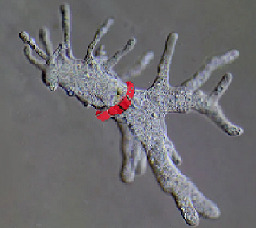
13. Height?
5'6 yayy i can go on all the rides at kentucky kingdom ^_^
14. Favorite school subject?
Biology. i love to learn about the animals and the cells and the krebs cycle and and and
15. Dream job?
would be so dope if i got to do graphic design like professionally. ideally doing some cool branding shit for bands or record labels and shit but thats probably a pretty narrow market. close second is definitely something involving marine biology, even though i definitely do not have the education for it. i long for the depths. i do like what im doing now working on cars but i do not wanna do it forever.
IDEALLY i could be like a bohemian socialist trophy spouse to a friedrich engels type who could pay my rent for me while i fuck around and get high and write up a bunch of theses and essays and bad erotica all day. but fucking alas we live in a society
I tagggg uhhhh @phantomfitzroy @ghost-in-your-computer @foolive @aethersmite @midbyte andddd whoever elseee wishes to anser auhahahahuahahhhh
5 notes
·
View notes
Text
Book Bans in Kentucky
As of June 2023



Tricks by Ellen Hopkins
Brief Summary: Five stories following five teenagers of different sexuality, identity, and socioeconomic standing seem completely different yet illustrate hardships found far and wide in our society. Yet, the consequences - good or bad - of three words, "I love you," brings their stories together in beautiful and devastating ways.
Banned from libraries and classrooms as of February 2023, based on a formal challenge.
Amazon | Barnes & Noble | Blackwell's (UK)
Out of Darkness by Ashley Hope Pérez
Brief Summary: The heartbreaking story of two adolescents finding love on opposite sides of segregated lines. A historical fiction set around the New London school explosion in New London, Texas, 1937, recounts and retells a harrowing tale of love, heartbreak, segregation, and the ways humans can fall apart.
Banned from libraries and classrooms as of February 2023, based on a formal challenge.
Amazon | Barnes & Noble | Blackwell's
Lucky by Alice Sebold
Brief Summary: A memoir, Alice Sebold recounts how she was sexually assaulted as a college freshman at Syracuse University and tells her truth as a victim of trauma. "You save yourself or you remain unsaved."
Banned from libraries and classrooms as of February 2023, based on a formal challenge.
Amazon | Barnes & Noble | Blackwell's (UK)
Statistics Source: Pen America
Support the American Library Association!
#books#banned books#book banning#book bans#censorship#literature#libraries#librarian#books and libraries#booklr#bookblr#studycore#reading#reading aesthetic#dark academia#light academia#chaotic academia#academia aesthetic#keep reading#book recs#book rec#book recommendation#book tumblr#book blog#ya books#bookworm#to read#to read list#to be read#tbr
3 notes
·
View notes
Text
Nina Ferraro Stereotypes in sports affect athletes’ opportunities, performance and perceptions
Can a stereotype shape a person’s journey? In the world of sports, athletes are constantly battling not just their opponents, but also the stereotypes and prejudice that can interfere their destiny on the field or in the arena. Nevertheless, stereotypes, “an often unfair and untrue belief that many people have about different groups”, are not limited to just race, gender or ethnicity: no sooner they reach into the competitive world of sports. Furthermore, the impact of these stereotypes is profound, shaping athletes' opportunities, performance, and the way they are perceived by society.
The historical context is essential to be considered to truly understand the impact of stereotypes in sports. Throughout history, sport has often mirrored societal prejudice, with gender, race, and ethnicity playing key roles in shaping these perceptions. From the exclusion of women in early Olympic Games to the racial segregation in baseball, sports have reflected and reinforced stereotypes. However, it is important to know that prejudice has been present for a long time. For instance, in the 20th century, women were discouraged from participating in sports, reinforcing the stereotype that they were physically inferior to men. Racial segregation and discrimination in sport further brought the stereotype idea of athletic superiority for certain racial groups.
These preconceptions in sports can manifest in many different ways. Athletes often find themselves battling not only their physical opponents but also the biases ingrained in the structures of their chosen discipline. Even if it's the perception that certain races excel in particular sports or that women are less capable of achieving athletic performance, these stereotypes seep into the minds of both athletes and spectators. They influence a lot of aspects, such as the team selections and the expectations placed upon athletes. That's why most athletes don't choose the sports they actually want to play. For example, young girls decide not to participate in male-dominated sports like football, fearing they might not be taken seriously. Similarly, boys who wish to be and play activities traditionally associated with girls, like gymnastics, often face pressure, discouraging them from following their passions. In both cases, stereotypes can create barriers for individuals to choose their true athletic interests, limiting the diversity and inclusivity within this world.
Zaid Jilani, a journalist, wrote an article about how to beat stereotypes by seeing people as individuals. He tells about an experiment that was done: a group of teens from University Heights High School in New York City talked to a different group of students from Kentucky. Therefore, they learned that there isn't much separating them. As a result, the text tries to share with us that not having these inaccurate beliefs about other people it's essential and important to have compassion for others and to really understand their capacity and reality.
With all that, it’s concluded that in the world of sports, stereotypes have a deep influence on athletes’ lives, not only impacting their opportunities but also society’s perception. The historical context is important to be considered when we discuss the influence these biases have, such as in sports chosen younger children, limiting the diversity in it. To combat these, it is demanded to see people as individuals and forget the preconceived notions that people tend to have.
2 notes
·
View notes